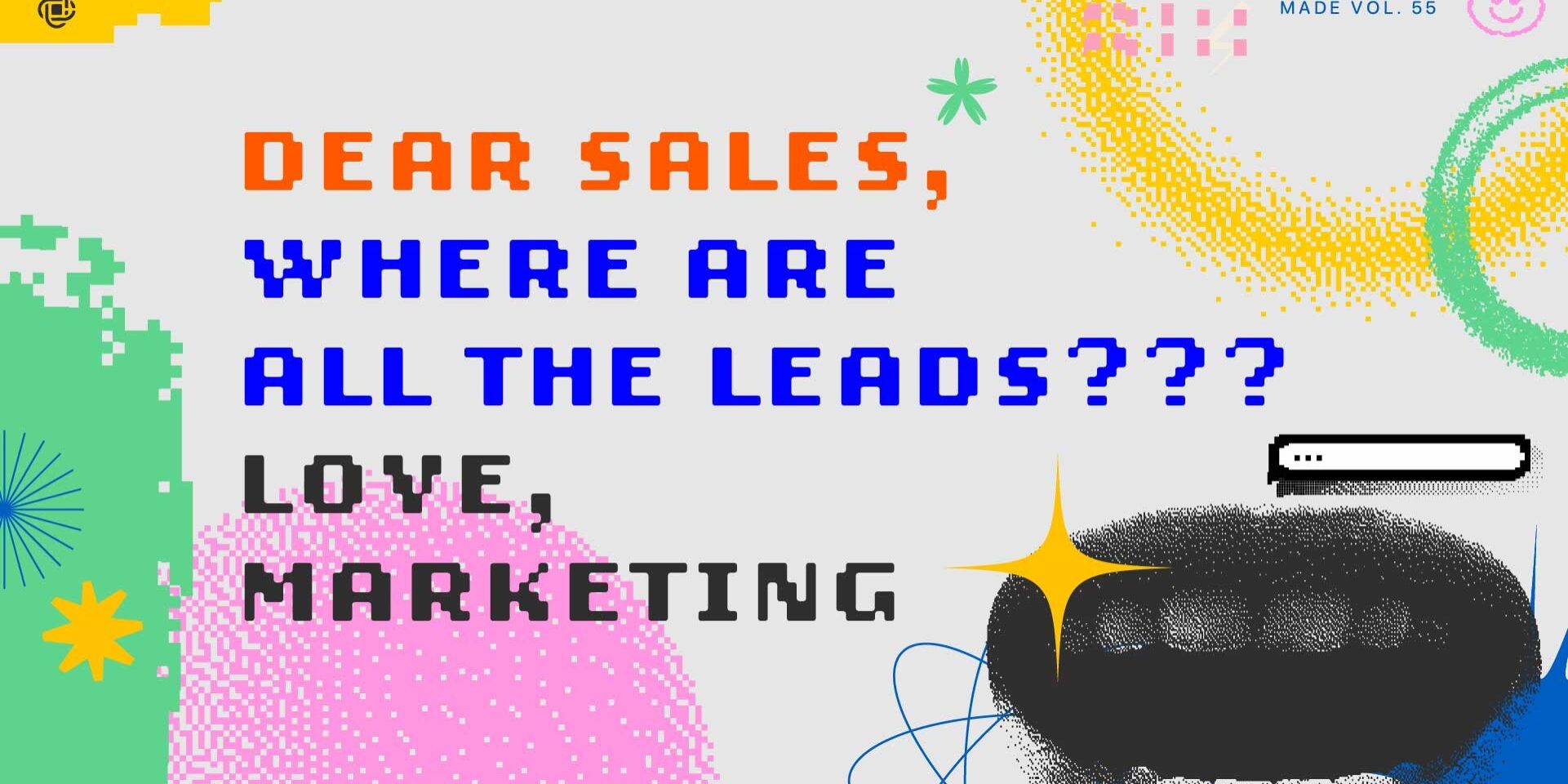It’s just another day at a company like yours. And like any other day, shots get fired between marketing and sales:
Dear Sales,
This email is in regards to my previous three emails about leads – for which I still have not received a reply. Like the previous ones, I’m asking a simple question: Where’re all the leads? Seriously, Sales, where are they?
Look, I’ve worked very hard to bring a string of motivated potential customers to your door. I entertain them, I extoll our brand, and I do all these things to make your job easier. And because CEO made me. But still, I do it all day every day.
I don’t know what’s happening when these leads get to you, but I do know they’re not here afterward.
Take Suzanne for instance. Bright, lovely, sweet – she was looking for something but she wasn’t sure quite what or whom she wanted to buy it from. Enter me: charming, captivating, obviously focused on her and her needs. She was hooked. She signed up for the newsletter, went to the webinar on the 10th, and liked all our posts on social media. She was excited! She told me she was ready to talk to you, so I showed her the way.
That was six days ago. This morning I see that Suzanne has unsubscribed from our newsletter, hasn’t registered for the webinar at the end of the month, and hasn’t liked a post in nearly a week.
WHAT THE HELL DID YOU DO, SALES!?!
This is not the first time this has happened. It happens A LOT. For the love of god, Sales, whatever you’re doing, DO IT BETTER. I hate to say it, but, why can’t you be more like me?
Anyway, we NEED to talk. Come see me when you get back from your imaginary coffee date. If I don’t hear from you, I’ll have to take this to CEO. DON’T make me take this to CEO, Sales. You remember how mad and confused she got last time.
Love,
Marketing.
Why Aren’t Sales and Marketing Friends Anymore?
For decades, there has been a relentless battle between marketing and sales. It started far off in marketing’s origin story. Back then, sales wasn’t getting in front of enough opportunity – despite its best efforts. So advertising became“marketing” and left to be sales’ assistant in the race for revenue.
But now, the line between sales and marketing has blurred to the point of invisibility. SDRs are making contact way up funnel, and marketing is happening up to and through the point-of-sale. No longer relegated to the front end, now it lives across the whole spectrum of a buyer’s journey.
Speaking of which, the buyer’s journey is now far from linear, further complicating the sales\marketing coexistence. Because there’s no telling where in the journey a buyer may enter, exit, re-enter, etc., both sales and marketing feel the need to be constantly present and available, whether the customer wants them there or not.
You can feel the fallout of this tension as a constant ping-pong of blame and responsibility between marketing and sales.
Meanwhile, marketing gets more and more expensive while sales is converting less and less. There is no clear line of accountability to revenue, so executives just spend their time navigating the blame game.
In response, today’s buyers, particularly in B2B, have gated themselves from marketing and sales. The sophistication of buyers has risen far faster than the sophistication of sellers, and the gap is costing middle-market companies millions.
Marketing Makes It Worse (Yeah, We Said It)
Making matters worse, marketers across the spectrum still believe the lie that they are producing leads for sales to close. We know that because we hear it all the time from exasperated marketing departments, angered by the sales team’s lack of closing ability.
While this idea of marketing-capturing-leads-for-sales-to-close might have been true even ten years ago, in the late-digital marketing age, buyers reject these shortcuts.
But because this lie is still believed and passed on between marketers and CEOs, the pressure from marketing to sales to “work the leads” they send them intensifies.
Sales, because of their lack of marketing knowledge, tries to convert the worst leads: people who signed up for gated content.
Entire sales teams are getting gutted in the process, while marketing smirks, washing its hands of the mess it helped create.
the real job of marketing
First things first, marketing departments (and the CEOs they answer to) need a reality check. Marketing’s job is no longer to build a funnel and usher people into a slippery slope that ends in a buying decision.
70% of the buyer’s journey is happening outside of the funnel. That means it can’t be measured by clicks, engagement series, webinar registrations, or SDR dashboards. All of marketing’s old and insistent metrics are today incomplete at best, and total distractions at worst. On metrics alone, most marketing departments getting what they measure, and what they measure is often not worth having.
But we also understand that the job of marketing has changed, and that means it shouldn’t be measured using its well-defended criteria.
New job, new criteria.
Customers are making their decision, EVERY DECISION, on reputation first. When every marketplace is flooded with options, customers have reverted to an old-school metric to decide which brands they will do business with.
And that metric is reputation. Which doesn’t come overnight, can’t be easily paid for, and must be consistently attended to in order to grow.
Marketing can no longer wait for the customer. It has to go to where the customer is and build engagement there. Not a funnel. Not a series of funnels. Engagement. Engagement as a result of building a first-party community around a tight network of buyers whose measure of the brand is its reputation.
Easier said than done, right? We were thinking the same thing.
CultureCraft Founder Nick Richtsmeier will be hosting a masterclass on August 10th to help teach CEOs and middle-market Managers how to buy marketing services in today’s late-stage digital hellscape.
Could you use some direction?



